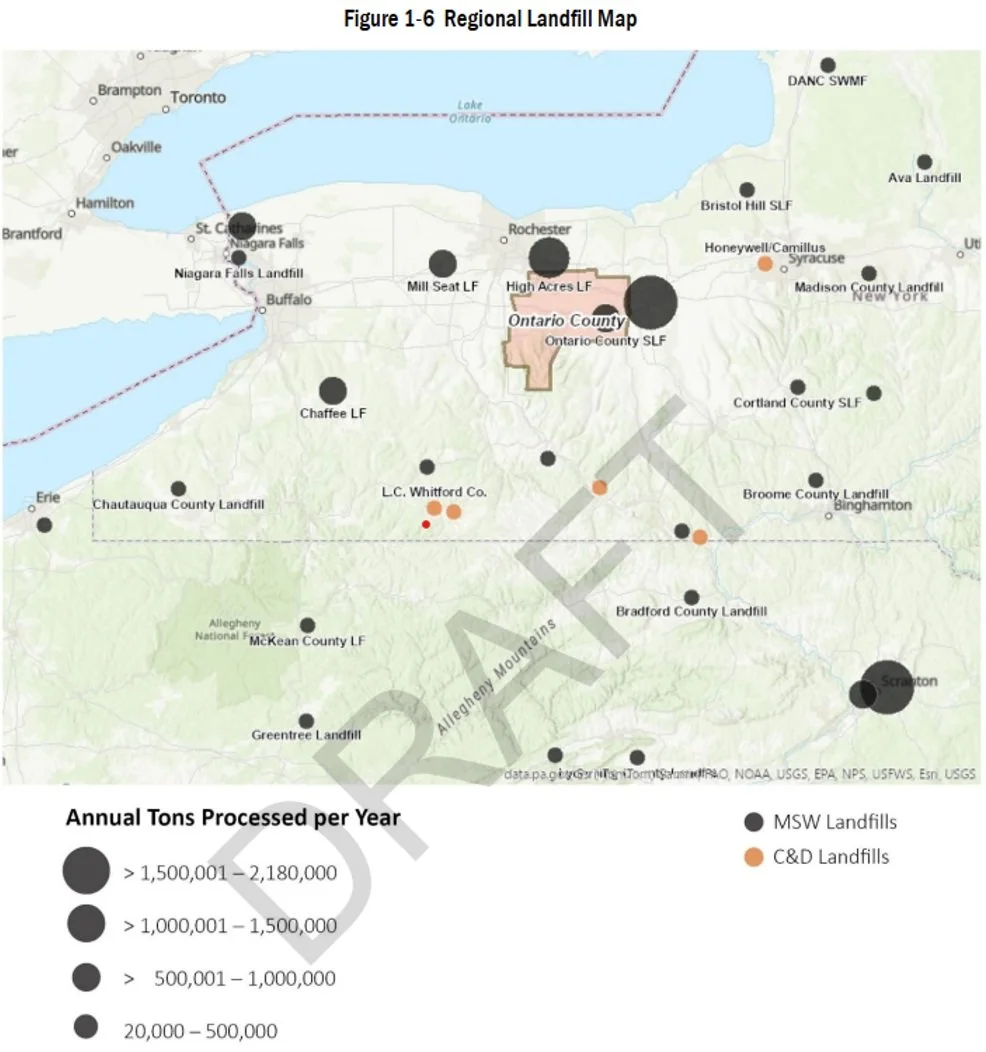FUTURE WASTE MANAGEMENT SCENARIOS
The future of solid waste management in Ontario County depends on whether the landfill is closed and all waste is exported to a landfill outside of the County/State, or whether it is expanded and operations continue at the current landfill site. The four waste management scenarios below outline the challenges and advantages of each option.
Expansion Scenarios
SCENARIO 1: VERTICAL LANDFILL EXPANSION
This option would involve placing additional wastes on top of the currently permitted acreage.
Analysis shows that there is a potential additional capacity for 5.9 million tons, which amounts to a 144 ft. height increase over the currently permitted elevation.
The 144ft vertical expansion can be adjusted downward, with a decrease in associated capacity.
| 100% Fill (144 feet add’l elevation) |
50% Fill |
||||
|---|---|---|---|---|---|
| Scenario | Annual Tonnage | Add’l Capacity (Million CY) | Landfill Life | Add’l Capacity (Million CY) | Landfill Life |
| 100% Fill Rate | 700,000 | 5.9 | 2037 | 2.9 | 2033 |
| 50% Fill Rate | 350,000 | 5.9 | 2045 | 2.9 | 2038 |
| County Waste Only | 100,000 | 5.9 | 2083 | 2.9 | 2057 |
SCENARIO 2: HORIZONTAL (LATERAL) LANDFILL EXPANSION
This option would require new cell development on existing parcel acreage to expand the landfill footprint.
Due to environmental site constraints, it has been determined that only about 700,000 tons of additional capacity could be added to the landfill if a horizontal expansion is pursued.
Under the current fill rate, this expansion would provide the landfill one additional year of operation. And seven years if the landfill only accepts Ontario County generated waste.
To see how each of these scenarios effects your specific municipality go to Appendix I.
Closure Scenarios
SCENARIO 3: LANDFILL CLOSURE/EXPORTATION
This scenario means all Ontario County waste will need to be exported out of county to a different landfill.
Some local municipal and private haulers will need to drive to more distant landfills.
Haulers will incur additional cost for further transportation.
Tip fees will change based on available landfill capacity and the number of competing landfills in the area.
Costs to customers will be dependent on disposal agreements between haulers and landfills.
SCENARIO 4: LANDFILL CLOSURE/EXPORTATION WITH COMMERCIAL TRANSFER STATION
Development of a commercial transfer station at the landfill site would act as a central location where collection trucks can tip waste to be consolidated into long haul trucks for transport to a distant landfill.
Consolidated waste produces the possibility to market larger volumes of waste to secure reduced tip fees, resulting in longer term commitments.
Only specific types of waste can be accepted for transportation at a commercial transfer station. Examples of wastes that would be excluded are: biosolids, asbestos, and some industrial wastes.
This option would require capital investment in infrastructure, permit applications, and procurement processes to secure a future operator.

